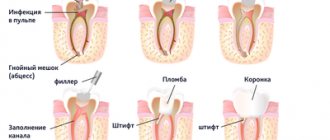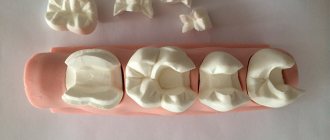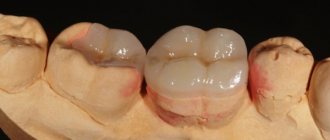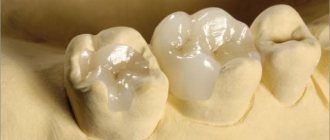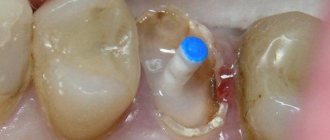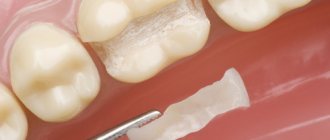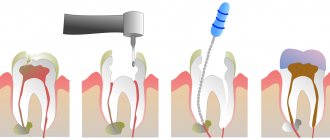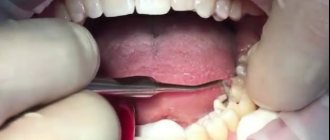A stump inlay is a microprosthesis, which is a tooth stump made of metal, ceramics or zirconium dioxide. It is used when there is significant destruction of the crown part of the tooth and the root is intact. The prosthesis fills the resulting void and creates a support on which an artificial crown is placed. Before installing the inlay, the tooth must be depulped.
A tooth stump inlay is a reliable prosthetic method. With a well-sealed canal and the choice of high-quality materials (for example, gold), it lasts up to 15–20 years.
At the Mitino Dental Center you can get advice from a qualified orthopedic dentist, as well as perform any type of dental prosthetics.
What is a stump tab
A stump inlay in dentistry is a pin structure used for prosthetic purposes when it is impossible to restore the natural tissues of the coronal part of the tooth. The inlay is attached to the root part, protruding onto the visible surface of the tooth, forming a support for the artificial crown. The main condition for its use is the ideal health of the tissues and roots surrounding the unit. The stump tab, in contrast to the anchor pin, intended only to strengthen the tooth, consists of two parts: the lower one, installed in the canal, and the upper one, which gives the tooth its shape. The system rests on the surface of the tooth being restored and is able to evenly distribute the load on the root.
Why are core inlays better than fillings and pins?
Fillings and pins are only applicable if the tooth has a sufficient amount of healthy tissue remaining. If only the root or thin walls of the tooth remain, then it cannot be restored with a pin, since such a restoration method will not be distinguished by either quality or reliability.
Firstly, under load, the pin can break and in the process damage the tooth root. Trauma to the root of a tooth is a direct indication for its removal; no methods for damaging the root system will help you save your tooth.
Secondly, dentures installed on large fillings and pins most often fall out some time after prosthetics. In this case, the treatment will have to be carried out again, and this implies new and significant financial costs.
IMPORTANT: Some dentists try to fix the fallen crown and pin with cement. But this is useless: the structure will not hold firmly, and in addition, an inflammatory process may begin under it, leading to rotting and destruction of the tooth.
Therefore, in case of severe tooth decay, only a stump inlay can provide high-quality and durable prosthetic results.
Manufacturing technology of the stump tab
- The method of layering ceramics. After receiving the impressions, a refractory model is made, a ceramic pin is tightly installed in the channel, ceramic is applied to it, and firing is performed. In the process of applying ceramic layers, it is possible to choose different colors and shades of the material, dyes and modifiers.
- Production of ceramics from tablet molds by pressing. An inlay is modeled from wax, and sprues are installed in the direction of the ceramic flow. Using a silicone ring, investment material is introduced and a limiter is placed. Pressing is carried out in an oven equipped with a microprocessor control system. The resulting product after pressing and casting is a solid single crystal, the abrasion of which is comparable to the natural abrasion of hard dental tissues.
- Manufacturing using CAD/CAM method. Allows you to form prostheses and parts that match the implant, abutment, and the shape of the tooth stump. The unit is scanned in the mouth or on a model, 3D modeling is carried out using a special program, the information received is transferred to a milling machine, which mills the product under computer control. The method is precise and complex, requiring high costs for professional training of personnel to operate the equipment.
- Injection molding method for manufacturing a stump insert. Casting a working model from plaster/polyurethane, selecting an ashless pin similar to the root canal, applying silicone varnish to the root. The pin is inserted into the canal and modeling is carried out with ashless plastic/wax. After a control check, the cast stump insert is removed and transferred to a metal casting. The method is technologically easy, low-cost, requires a minimum of material costs, but is very sensitive to the quality of casting. With strict adherence to all norms and rules, reliable and high-quality microprostheses are obtained.
Service life and care features
The service life of zirconium dioxide is very long - 15, 20 and even 25 years. Such long-term operation will depend both on the quality of preparation of the tooth for prosthetics and the accuracy of the fit of the orthopedic structure, as well as on compliance with the rules of wearing and caring for prostheses. What is needed for this? Do not forget about regular brushing of your teeth in the morning and evening, avoid hard and stretchy products (so that the denture does not come off). Ideally, you should also visit your podiatrist twice a year for a checkup.
Manufacturing methods
- Straight. It is characterized by its low cost, ease of implementation, and does not require the presence of fire-resistant models or impression materials. With the direct protocol, the future core inlay is modeled in the oral cavity, and then dental laboratory specialists replace the wax with the working restoration material. Disadvantages: insufficient visibility of the surgical field, risks of thermal injuries to the mucous membrane, large time expenditure for the dentist.
- Indirect (indirect). It is used for all types of defects; production takes place in two stages: obtaining an impression plus obtaining a model.
Price
The stump model of the prosthesis is not a cheap dental structure. Its cost may vary from one dental office to another. The most inexpensive is the metal model (on average from 2,000 to 3,000 rubles). A prosthesis made of pressed ceramics costs about 12,000 rubles. And most of all you have to pay for the zirconium dioxide inlay (about 15,000 rubles).
If your tooth is damaged, but its root is not damaged, do not worry! Modern designs in the form of a stump tab will help you preserve and strengthen a hopeless tooth.
Sources used:
- I. Yu. Lebedenko, Orthopedic dentistry, 2012
- Seifollahi M. Preparation of lateral teeth for all-ceramic inlays
- https://medicine.wustl.edu/
Indications for installation
- destruction of the crown part of the tooth;
- periodontal diseases (splinting);
- defects in the shape, position of the unit, supragingival area;
- There is no way to put a pin with a filling. For example, if the chewing teeth are destroyed.
Contraindications for installing a post-core restoration on a pin
: caries, cysts, damage or absence of roots, gum disease, periodontal disease, pathological mobility of the dentition, allergies to the alloys from which the structure is made.
We offer
:
- single crowns;
- veneers, lumineers;
- bridge-like devices;
- implant-supported restoration;
- systems with stump pin system.
Composition and application of microprosthesis
Compound
The prosthetic structure consists of a pin part that completely follows the shape of the root canal, and a stump that imitates the crown being restored. Most often, stump inlays are made from various metal alloys through precision casting. However, zirconium or aluminum oxide can also be used to produce prostheses.
Application
Standard cast pins are used to create tooth stumps with pronounced destruction of their supragingival part and the presence of healthy, strong roots. In this case, the tab is tightly fixed in the root canal so that its stump part protrudes above the gum. The stump can be used as a support for crowns, splinting structures, removable and fixed dentures.
In modern dental practice, collapsible and non-removable stump inlays are used.
Non-removable structures are used to restore teeth with one root, and collapsible ones are used to create tooth stumps with two or more roots.
Advantages of stump inlays
Compared to other post systems, the stump post is much stronger. The inlay distributes the load more evenly and fits tightly to the remaining teeth, which prevents the formation of cracks and the development of caries.
Other advantages include the possibility
:
- regenerate destroyed/lost units;
- support natural teeth with bulk fillings;
- remove increased abrasion of tooth enamel;
- restore anatomical form/functionality;
- align curvature, maintain aesthetics;
- make prosthetics on implants.
Are there any contraindications to the use of stump pins?
Unfortunately, not in all cases, stump pin inlays can be used for dental prosthetics.
Stump inlays should not be used under the following circumstances:
- When a tooth is destroyed below the gum level;
- When the quality of root canal filling is poor. In this case, it is necessary to unseal the canals, reprocess and seal them, and only then install a pin stump inlay and crown;
- A contraindication to the use of a pin stump insert would be an inflammatory process in the area of the tooth root;
- Allergy to the materials used to make the stump inlay on the pin.
Also, inlays are not placed on loose and mobile teeth.
IMPORTANT: In some cases, a stump pin can still be installed even if the tooth is destroyed below the gum level. But this will first require an additional operation - an osteotomy. The essence of this operation is to cut down the bone tissue to such an extent that the gum is below the destroyed tooth.
Comparison with classic pins
Standard pins - pros:
- gentle tissue preparation;
- the ability to conduct therapy in one session;
- low price.
Minuses:
- the coronal and intraradicular segments of the restoration may become separated because there is no chemical bond between them;
- in the case of active rods, there is a risk of a wedging effect during the screwing process;
- the absence of a base in the structure leads to a sharp increase in the propping load on the root during operation;
Pros:
- the stump and the pin are cast from identical material and connected, which 100% eliminates the possibility of their separation;
- slight wedging effect during cementation of the stump inlay;
- minimizing disjoining pressure, since the chewing load is transferred to the walls of the root, along its axis, to the rod.
Stump pin inlays can be used when the destruction index of the occlusal surface of a unit is more than 60-100% (standard pins - 50-60%). Such inlays are durable and guarantee the reliability of the structure.
Our dentistry offers installation of several types of core microprostheses
:
- serve within 5-25 years;
- reliability of crown fixation;
- excellent strength;
- simplification of subsequent fastening of bridges;
- the ability to work with any degree of destruction, restoration of bite;
- lack of access for pathogens. No inflammatory processes;
- simple replacement of the prosthesis if necessary.
What are the differences between inlays and pins?
The most important difference between the core inlay for a crown
from the pin is that the latter is installed under the filling. Previously, this approach was widely practiced to restore severely damaged teeth... However, in the end they abandoned it, since it led to the development of secondary caries, which was not easy to detect under the filling. The result was not comforting: extensive damage to the tooth by the disease and (often) its removal. As for other differences, they are presented in our table:
| Indicators by which the assessment is made | Stump tab | Pin |
| Fit tightness | High, which eliminates the penetration of pathogenic microorganisms and the development of secondary caries. | Not good enough, which allows bacteria to penetrate into the dental cavity and provoke the development of secondary caries. |
| Ability to withstand intense chewing loads | High | Low, which leads to destruction of the filling. |
| Lifetime | Long | No more than two to three years |
| The need for replacement when the crown wears out | Not required | Not required |
| Number of visits to the doctor for installation | Two visits | One visit |
| Necessity of preparation | Requires significant grinding | Requires minor trimming |
| Price | More expensive than a pin | Cheaper than a stump tab |
Based on the above, we can conclude that despite the higher price, a stump inlay is preferable to a pin. After its installation, you can use a crown and get a durable structure that prevents further tooth destruction.
Classification of stump inlays
| View | Description | |
| By installation method | ||
| Cast | Manufactured under high pressure and temperature. The non-separable model consists of a main part and pins for fixation. Can be replaced over time | |
| Collapsible | Designed for two to four channels. Similar in design to cast ones, only some pins are made removable. This is due to the fact that channels do not always have a symmetrical structure. Comes with a lifetime warranty | |
| Based on base material | ||
| Metal | These can be cobalt-chrome, precious metals and their alloys. They are characterized by increased reliability. Disadvantages include an unaesthetic appearance, which is why they are most often placed behind the smile line | |
| All-ceramic | Made from zirconium dioxide or pressed ceramics. Zirconium is as durable as its metal counterparts. Ceramic inlays are aesthetically pleasing and natural-looking, which is why they are used for front teeth. All-ceramic ones are produced automatically. This ensures maximum compliance with the bite | |
| Metal-ceramic | Products made from metal ceramics are of average quality and affordable price. Due to the difference in thermal expansion of metal and ceramics, there is a high risk of falling out | |
| Composites | Composite inlays are rarely used due to their low durability | |
Important
: It is desirable that the materials of the pin and crown parts of the core structure coincide. For example, if the core inlay is metal and the crown is ceramic, then the metal will be translucent.
Sign up for installation of dental inlays at a discount:
What is a tooth core?
Stump inlays are structures that enter one third of the tooth canal, restoring the lost part of the tooth from above. A crown is installed on top of the stump inlay, which is made from the material chosen by the patient.
Often there are teeth restored with “extended” fillings on pins. It should be noted here that some dentists install huge fillings on their patients’ posts instead of crowns. Such fillings do not last very long, and they fall out even if you do not chew anything hard. As a result of chewing, this huge filling, together with the pin, goes sideways and breaks the root of the tooth in which the pin was installed. Such a root usually has to be removed. In rare cases, it is possible to install a crown on a broken tooth. This usually happens in cases where the crack is not below the level of the gum.
How long have dental inlays been used on the Russian dental market?
Quite a long time ago, more than 10 years. It’s just that not all patients agree to visit the doctor several times. They want to do everything in one day, so they choose large fillings, fillings on pins (“extended”). Some doctors make concessions to such patients and do as the patients want, but this is wrong. A healed tooth with a large filling will simply chip quickly, and there is a chance of losing the tooth altogether, so it is better to put an inlay on it.
How many tabs have you installed as a specialist?
Hard to say. I've been working with tabs for about five years. We install 10-15 tabs per month. There are patients who need to install several inlays at once, for example, due to increased tooth wear.
Let's summarize our conversation. What is better - an inlay, a crown or a filling?
Everything is done according to indications, but, of course, a ceramic dental inlay is best.
Let me give you an example: I had patients who had a ceramic inlay installed on one side and a metal-ceramic crown on the other. And according to reviews, the inlay is much better, since most often food gets under metal-ceramic crowns and accumulates under them. This may cause an unpleasant odor.
If metal-ceramic crowns were installed, the metal edge may be exposed, which does not add aesthetics.
Patients also do not like large fillings, which shrink after a certain time, and there is a high probability of chipping the tooth wall or caries.
In these cases, tabs are the best option.
Doctor, thank you for the detailed story!
Multi-channel and single-channel tabs
When treating a multi-rooted tooth, the doctor must make a decision: to make a collapsible or solid-cast core microprosthesis. If the root canals run parallel, solid blanks are used. Before choosing one of the various options for inlays, the patient is diagnosed - they take pictures and CT scans. Computed tomography helps to visualize the condition of the root segment, the configuration of the canals, and the presence of bone and periodontal diseases that require treatment. A multi-root microprosthesis is a good option because it creates uniform pressure on the entire tooth while being held in several canals at the same time. A crown with such a base can be used to mount a bridge restoration without the risk of destroying or damaging the tooth.
Requirements of orthopedic dentistry for the use of core inlays:
- the root canal must have good patency over a length identical to the length of the pin;
- absence of purulent-inflammatory processes in the root zone;
- the walls must be of sufficient thickness (2 mm or more) to resist the chewing load transmitted through the stump structure, the protruding area must not be affected by caries;
- the stump should not be covered by the gum, otherwise gingivectomy is indicated;
- apical tissues should not have manifestations of chronic/acute inflammation.
Fixation
Restoring a damaged tooth begins with a step-by-step treatment of its roots. The first thing to do is to remove the nerve and perform a high-quality cleaning of the canals. If these measures are not taken, a strong inflammatory process will occur in the future, due to which the restoration will have to be removed.
The tooth is then prepared from the inside. To do this, the prepared and sealed root canals are carefully unsealed to approximately 1/3-2/3 of the length. Their diameter must be increased. Subsequent procedures involve taking impressions.
When the stump tab is ready, it is installed:
- The damaged tooth is disinfected.
- The prosthesis is degreased and covered with adhesive dental cement.
- A material is placed in the channels that improves the adhesion of artificial fabrics to natural ones.
- Carry out installation.
To ensure that the device is securely fixed, apply strong pressure to the nago. After gluing the supporting element, all that remains is to take impressions and make a crown.
Stages of manufacturing and installation of dental prostheses
We work in several stages
:
- Preparation. We remove the carious area, perform a filling, take an x-ray for verification, and form a cavity.
- We unseal the roots by half or one third, giving them a taper and width. It is also important to choose the optimal tab option.
- We take an impression of both jaws and cast it from plaster in a dental laboratory. It is important that the microprosthesis corresponds to the antagonist organ.
- We scan the cavity and carry out modeling on a computer.
- We send the task to an automated milling machine, which produces the product.
- We burn the workpiece in a special oven.
- We treat the area with an antiseptic and fix the fat-free microprosthesis with cement.
- Trying on and selecting a crown, installing a finished core inlay.
What is it - a tooth tab?
Dental inlays are microprostheses that can be used for different purposes. Restorative or restorative inlays are used like fillings: they help recreate the natural crown of a tooth, keeping it alive. Stump inlays are used in cases where it is necessary to restore a badly damaged tooth under a crown. Let's take a quick look at why restoration and stump inlays are used, and find out the difference between them.
Restoring inlays are stronger than conventional dental fillings and differ from them in the technology of their creation: dental inlays are not made directly in the patient’s mouth, like fillings, but in a dental laboratory, using previously taken impressions. Because microdentures are made in a laboratory setting, they are also called indirect dental inlays.
The inlays exactly repeat the shape of the cavity that needs to be closed for tooth restoration and fit tightly to the natural tissues. The high density of adhesion of the inlay to the tooth tissue eliminates the risk of developing caries in the gap between the installed microprosthesis and the tooth. Restoring a tooth with an inlay will help keep the tooth alive in a situation where a sufficient amount of tooth tissue has been preserved, its nerve is alive and well, but a large filling still needs to be placed. Large fillings do not stick well to the teeth and can break under stress, along with the tooth. Inlays have a long useful life, can withstand chewing loads well, and their use makes it possible not to rush into dental prosthetics with a crown, which often requires preliminary depulpation of teeth.
Stump inlays for a tooth are no longer a restoration element, but a technical one. It acts as a support for the installation of a dental crown in cases where the tooth cannot be restored qualitatively with a conventional filling. In order not to confuse stump and restoration inlays, the easiest way to classify them is as follows: restorative inlays are installed outside the living tooth, stump inlays are always located under the crown.
This is the main classification of inlays, but they can also differ in the type of material they are made of, and below we will definitely talk about all the types of microprostheses and their features. But first, let's find out who and when is recommended to install inlays on teeth.
Complications and errors
Errors in the manufacture of core inlays are divided into two groups: those associated with the work of the orthopedic dentist and the actions of the dental technician.
Clinical:
- unsealing of the canal to an unsatisfactory amount;
- root perforation during teeth grinding;
- giving an inadequate shape to the channel, which can lead to de-cementing of the structure;
- errors when taking impressions.
Laboratory:
- poor-quality casting when using the casting method;
- non-compliance with processing standards during the pressing method;
- violation of the firing regime when applying ceramic layers.
Quality criteria for core restoration: high aesthetic level, reliable fixation, long service life, uniform distribution of pressure when pressed.
Advantages of a stump inlay
Most people know about the use of pins for damaged teeth to strengthen them. However, it is the shape of the core inlays that is more similar to the natural shape of the tooth. This type of denture has undeniable advantages for use:
- Protects sensitive enamel from abrasion.
- Preservation of chewing teeth from destruction.
- Large selection of crowns.
- It can be combined with other types of dentures to strengthen the dental crown or bridges.
- Rational distribution of food load (especially important for sick or damaged teeth).
- Long service life.
- Giving the tooth an ideal shape.
- Possibility of correcting the position of teeth (in some cases).
- Possibility of use for front teeth.
- Resistant to food staining.
- Possibility of replacing the crown with another one.
- Use for problem roots (periodontal pathology, curvatures, various degrees of obstruction, etc.)
- Use when restoring teeth after injury or caries.
- Reliability of prosthetics in the presence of significant dental cavities.
- Particular strength due to the technology of simultaneous casting of the inlay and pin.
- There is no need to replace the inlay in case of crown destruction.
- Guaranteed against fracture of the prosthesis thanks to the monolithic method of manufacturing the stump and pin.
- No access of microflora to the tooth and the occurrence of caries due to the maximum tightness of the fastening.
Hygienic oral care
After installing the microprosthesis, 10-14 days pass before fixing the bridge or crown. During this period, the prosthesis requires special careful care:
- chewing food with the opposite side of the jaw;
- exclude solid foods;
- teeth are brushed as standard;
- The oral cavity is rinsed with an antiseptic solution after each meal;
- the gums are treated with an anti-inflammatory agent.
Stump inlays do not require specific care. It is enough to regularly brush your teeth, undergo an examination by a doctor, and undergo a professional sanitation procedure. To clean crowns, it is recommended to use soft brushes, dental floss, and special brushes. With proper care and following the recommendations of dentists, the stump insert will serve you for many years.
Is it possible to put an inlay on the front teeth?
Inlays are not used for the restoration of anterior teeth. If there is a sufficient amount of healthy tooth tissue, the tooth is restored with a regular filling and then a veneer or lumineer can be placed on it to obtain a beautiful aesthetic restoration in the smile area. If the tooth is severely damaged, then it makes sense to install a stump tab and then a crown.
The traditional area of application for restoration inlays is chewing teeth.
Why us
- it doesn’t hurt: during installation we use different types of anesthesia, depending on the patient’s individual parameters;
- it’s fast: treatment will require 2-3 visits;
- it’s reliable: we provide a 3-year warranty;
- it’s convenient: we work with any materials – gold, zirconium dioxide, porcelain;
- it's safe: we have our own dental laboratory. We use equipment from European brands, which guarantees high accuracy and safety of products.
Restore a tooth that seemed hopeless - install a core tab at an attractive price at Dr. Razumenko’s dentistry in Moscow!
How it is made
What stages must be completed in order for a patient to have a high-quality stump prosthesis installed?
The specificity of the installation of stump inlays is the individuality of their production for each clinical case.
Before installing these structures, thorough sanitation of the mouth, filling of the canals and removal of the destroyed pulp in them is required.
Main stages of the process
- The orthopedist prepares the dental cavity for installation of the inlay.
- Then the specialist selects the optimal type of material, taking into account the basic parameters of the desired material (shrinkage, hardness, bioinertness, residual elasticity, thermal conductivity).
- The orthodontist makes impressions of the patient’s jaws to ideally “fit” the prosthesis into the dentition (with the obligatory consideration of antagonist teeth). The blank model is sent to the dental office.
- The variability in the manufacture of the prosthesis must be taken into account: single-root or multi-root (depending on the anatomy of the tooth being restored).
- The dentist makes a prosthetic model from the material selected by the orthodontist. Then a wax model is made from the plaster sample. Only after this do they proceed to the manufacture of a finished stump prosthesis from the selected material (metal, ceramics, composite).
- The structure is covered with a special corrective shell and sent to the doctor.
- In the dental office, the doctor processes the dental cavity and the finished inlay. After this, the prosthetic model is installed on the patient.
- Hiding the stump model of the prosthesis under a crown or bridge.
Prices for installing a stump tab
To find out the cost of a stump tab, sign up for a consultation at Dr. Razumenko’s dental clinic. To do this, fill out an application on the website or call: 8 (495) 380-01-38.
| Code no. | NAME OF PROCEDURES | Unit of measurement | Cost, rub. |
| 712 | Fixation of restoration with glass ionomer cement | 1 500,00 | |
| 735 | Single-root post-core inlay CAD/CAM | 7 000,00 | |
| 736 | Multi-root post stump inlay | 8 000,00 | |
| 737 | Single-root/multi-root post stump tab, collapsible | 9 000,00 | |
| 738 | Zirconium pin insert | 11 000,00 | |
| 739 | Cast pin insert with attachment | 12 000,00 |
* The prices indicated on the website are not a public offer. The exact cost of treatment can only be determined at an appointment with a doctor.
Prices for treatment in Moscow full price list
Share on social media networks:
Article Expert:
Razumenko Evgeniy Gennadievich
Chief physician and founder of the dental clinic. He has been working in aesthetic dentistry for many years, restoring teeth of any complexity with ceramic and composite restorations. Winner of competitions in aesthetic dentistry. Applies CAD/CAM technologies in prosthetics.
Work experience 22 years
What to choose when doing prosthetics - restoring a tooth with a core tab or a filling?
What to choose when installing a crown - restoring a tooth with a core inlay or a filling? This question is often asked to doctors by patients who decide to restore their teeth. This question can be answered this way: if your tooth is badly damaged, and you want the installed crown to serve you for as long as possible, it is better to choose not a filling, but a stump inlay.
Yes, prosthetics with a stump inlay will be more expensive than installing a crown on a regular filling, but all costs will be repaid by the long useful life of the prosthesis and the high quality of the prosthetics. Stump inlays allow you to save and successfully restore even the most hopeless teeth!
If you still have questions about stump inlays, you want to find out their exact cost and find out the possibility of using a stump inlay in your case - come to an appointment with specialists at our dental clinic in Moscow - “Firadent”! We will be happy to help you achieve a new beautiful smile with healthy teeth!
We recommend that you read
Clasp dentures
Metal-ceramic crowns
Nylon dentures
Veneers
What are the advantages of dental inlays?
In addition to the manufacturing technology, dentures in the form of inlays differ from fillings in the following parameters:
- Firstly, they are much stronger and more durable than fillings. For example, the service life of a ceramic inlay is 20 - 25 years. Not a single filling is capable of performing its functions efficiently for such a long period. It wears out faster and needs to be replaced. If this is not done, due to a violation of its anatomical shape, the bite begins to be fixed differently, the tooth no longer chews food so effectively, the patient has to make additional efforts, which negatively affects the jaw joints, provoking their diseases.
- Secondly, dental prosthetics with ceramic inlays reliably protects the tooth from further destruction, since ceramics is a durable material that can withstand any chewing and temperature loads. This is the only option for tooth restoration that helps to avoid subsequent pulp removal and crown covering.
